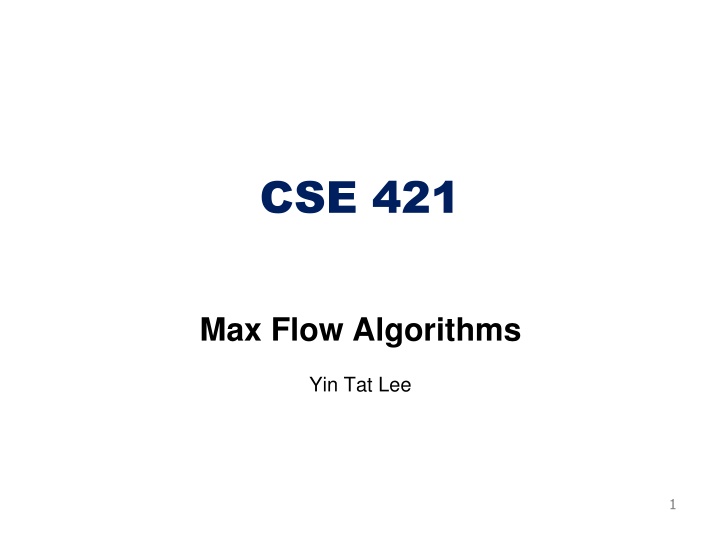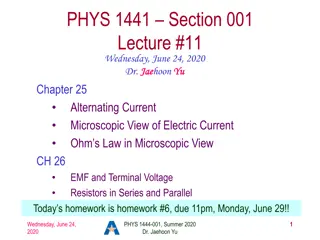
Max Flow Algorithms: Capacity Scaling for Graph Networks
Discover how capacity scaling improves runtime efficiency in graph networks, reducing the dependence on input size. Explore the concept, algorithm, and implications for max flow computations.
Download Presentation

Please find below an Image/Link to download the presentation.
The content on the website is provided AS IS for your information and personal use only. It may not be sold, licensed, or shared on other websites without obtaining consent from the author. If you encounter any issues during the download, it is possible that the publisher has removed the file from their server.
You are allowed to download the files provided on this website for personal or commercial use, subject to the condition that they are used lawfully. All files are the property of their respective owners.
The content on the website is provided AS IS for your information and personal use only. It may not be sold, licensed, or shared on other websites without obtaining consent from the author.
E N D
Presentation Transcript
CSE 421 Max Flow Algorithms Yin Tat Lee 1
Notations Given a directed graph ? with integral capacity 0 ?? ?. Input size is ?(?log?). We call a runtime ???(1) is pseudo polynomial. ?log??(1) is weakly polynomial. ??(1) is strongly polynomial. Ford Fulkerson takes ? ?? = ?(???). (Pseudo Polynomial). Dependence on ? is bad because ? can be much larger than ?. 2
Weakly polynomial: Capacity Scaling Question: How to improve ? dependence? Idea: Handle edges with large capacity first.
Capacity Scaling Let ??(?) be the residual ?? with all edges < ? capacity removed. Algorithm: Set ? = ? While ? 1 o While there is ?-? path ? in ??(?) Augment along ? by lowest edge capacity in ??(?) o Set ? ?/2 Correctness: When ? = 1, the inner loop is simply Ford Fulkerson. Hence, at termination, we have a maxflow. 4
Capacity Scaling 4 a x 3 5 3 7 7 4 s b y t 6 6 1 5 4 c z 5
Capacity Scaling 100 a x 011 101 011 111 111 100 s b y t 110 110 100 001 101 c z 6
Capacity Scaling Bit 1 100 a x 011 101 011 111 111 100 s b y t 110 110 100 001 101 c z Capacity on each edge is at most 1 (either 0 or 1 times =4) 7
Capacity Scaling Bit 1 100 a x 011 101 011 1/111 1/111 1/100 s b y t 1/110 1/110 100 001 1/101 c z O(nm) time 8
Capacity Scaling Bit 2 100 a x 011 101 011 10/111 10/100 10/111 s b y t 10/110 10/110 100 001 10/101 c z Residual capacity across min cut is at most m (either 0 or 1 times =2) 9
Capacity Scaling Bit 2 01/100 a x 01/011 10/101 01/011 11/111 10/100 10/111 s b y t 10/110 10/110 100 001 10/101 c z Residual capacity across min cut is at most m m augmentations 10
Capacity Scaling Bit 3 010/100 a x 010/011 100/101 010/011 110/111 100/100 100/111 s b y t 100/110 100 001 100/101 100/110 c z Residual capacity across min cut is at most m (either 0 or 1 times =1) 11
Capacity Scaling Bit 3 010/100 a x 010/011 101/101 011/011 111/111 100/100 101/111 s b y t 101/110 100 001/001 101/101 110/110 c z After m augmentations 12
Capacity Scaling Final 2/4 a x 2/3 5/5 3/3 7/7 4/4 5/7 s b y t 5/6 4 6/6 1/1 5/5 c z 13
Capacity Scaling Lemma: When the inner loop terminates for some ?, ??? ? ??? ? + ?? Proof: When the inner loop terminates, there is no ?-? path in ??(?). Let ? be the set of vertices reachable from ? in ??(?). Note that ??? ?,? ??? ? + ??. Hence, ??? ? ??? ? + ??. 14
Capacity Scaling Corollary: Inner loop takes ?(?) steps. Proof: Each step, ???(?) is increased by at least ?. But ??? ? ??? ? + 2?? at the beginning. Hence, there are at most 2? steps. Theorem: Capacity scaling takes ?(?2log?) time. Proof: Outer loop has ?(log?) steps. Inner loop has ?(?) steps. Each step takes ?(?) time. Algorithm: Set ? = ? While ? 1 oWhile there is ?-? path ? in ??? oAugment along ? by lowest edge capacity in ??(?) o? ?/2 15
Strongly polynomial: Edmonds-Karp Algorithm Question: Can we pick better paths to augment? Idea: Shortest Path!
Edmonds-Karp Algorithm Use a shortest augmenting path (via Breadth First Search in residual graph) Lemma: Let ? be a flow and ? a shortest augmenting path. Then no vertex is closer to ? in ?? after augmentation along ?. s Proof: Augmentation along ? only deletes forward edges no new (hence no shorter) path created adds back edges that go to previous vertices along ? BFS is unchanged, since ? visited before (?,?) examined v a back edge u 17
Theorem Edmonds-Karp performs ?(??) flow augmentations Proof: Call ?,? critical for augmenting path ?if it s closest to ? with min residual capacity. It will disappear from ?? after augmenting along ?. For (?,?)to be critical again, the (?,?) edge must re- appear in ?? but that will only happen when the distance to ?has increased by 2(next slide) It won t be critical again until farther from ?so each edge critical at most ?/2 times. Corollary: Total time is ?(?2?). 18
Distance for bottleneck edges Let ??(?,?) be the distance from ? to ? on ??. Shortest s-t path ? in ?? cP cP >cP >cP t x w s u v bottleneck edge ???,? = ???,? + 1 since this is a shortest path After augmenting along ? >0 >0 t x w s u v For (?,?) to be bottleneck again for some flow ? t x w s u v ?? ?,? = ?? ?,? + 1 ???,? + 1 = ???,? + 2 19
Faster Strongly polynomial: Dinic algorithm Question: What is better than 1 shortest paths? Idea: Multiple Shortest Paths!
Dinics algorithm Send as many shortest paths as possible at the same time. ? ?? distance to ? Keep on forward edges 21
Dinics algorithm Let ? be some flow. The level graph ?? is the graph with edges given by { ?,? ??:????,? = ????,? } We call ? is a blocking flow in ?? if {? ??:? ? < ???? } has no ?-? path. Algorithm: ? = 0 While there is ?-? path ? in ?? o Compute the level graph ?? o Find a blocking flow ? . o Update ? ? + ? . 22
Dinics algorithm Send as many shortest paths as possible at the same time. ? ?? ?? 23
Dinics algorithm Lemma: ???(?,?) increase every iteration. Proof (Draft): If distance doesn t change, a shortest path on the new graphs must be on the level graph. But there is no s-t path in the level graph after sending the blocking flow. Corollary: There are at most ? iterations. Proof: ?-? distance is bounded by ? and is increased by 1 every step. We can find blocking flow in ?(??) time picking path 1 by 1. Hence, Dinic s algorithm takes ?(??2) time. 24
Link Cut Tree There are a data structure that supports the following. make_tree(): Return a new vertex in a singleton tree. link(v,w,x): Make vertex v a new child of vertex w. Set the edge capacity to x. cut(v): Delete the edge between v and its parent. find_root(v) Return the root of the tree that contains v. find_min(v) Return the edge with minimum capacity on the v-root path. subtract(v,x) Subtract x from the capacity on the v-root path. Furthermore, all steps takes ?(log?) time. With this, we can send a flow in ?(log?) time in the level graph. Hence, Dinic s algorithm takes ?(??log?) time. 25
log [King Tarjan ] n log n 2 3,? Runtimes 1 2 log ?2 ? log?[Goldberg Rao 98] ? ? min ? Previous Best: ?(min(?1.5,??2/3)) [Even-Tarjan 75, Goldberg-Rao 89] Unfortunately, this slide was made in 2011 (during my undergrad). Undirected graph ??1/3/?11/3 [Christiano-Kelner-Madry-Spielman-Teng 2011] ??1/3/?2/3 [Lee-Rao-Srivastava 2013] ?/?2 [Sherman 2013, Kelner-Lee-Orecchia-Sidford 2014] ?/? [Sherman 2017] ? + ??/? [Sidford-Tian 2020] Directed graph ?10/7?1/7 [Madry 2013, Madry 2016] ? ? [Lee-Sidford 2013] ?11/8?1/4 [Liu-Sidford 2020] ?4/3?1/3 [Liu-Sidford 2020, Kathuria 2020] ? + ?1.5 [Brand-Lee-Liu-Saranurak-Sidford-Song-Wang 2021] ?3/2 1/328 [Gao-Liu-Peng 2021] ?3/2 1/58 [Brand-Gao-Jambulapati-Lee-Liu-Peng-Sidford 2021]
Shortest Path and Maxflow? Given an undirected graph with unit capacity and unit length. What is the relation between shortest path and maxflow? Let be the set of ?-? flow with value 1. Shortest path problem: min ? ||?||1. Maxflow problem: min ? ||?|| . Solving maxflow via shortest path is like using 1 problem to approximate problem. 28
Shortest Path and Maxflow? Fact: min ? ||?||2 can be solved in ?(?log?) time. [Spielman-Teng 2003] Instead of augmenting using shortest path, augment using 2 flow. This gives ? ? time algorithm. (2014) 29
Approximate Graphs with Sparse Graphs Every graph ? can be approximated by a sparse graph ? : ? has ?(?) edges ?????,? = (1 1 2)???? ?,? for all set ?. Using this, one can find the augmenting path on the sparse graph. This gives ? + ?3/2 time algorithm. (2020) 30
Creating shortcut in the graph Instead of looking at all vertices all the time, we can random sample some vertices and shortcut the graph. This gives ?3/2 1/58 time algorithm. (2022) 31
How about simpler graphs? Many graphs in practice has structures. One common class is planar graphs. For these graphs, we can solve maxflow in nearly linear time (2009) we can solve mincost flow in nearly linear time (2022) Guanghao Ye (was a 421 student) 32 Sally Dong






















